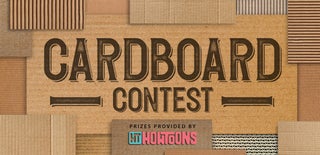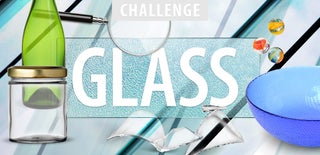Introduction: 3-Mirror Kaleidoscope
Hello community and Welcome to my First Instructable! (So happy to say that! :))
This idea came when I wanted to make something as a gift to a friend that loves Photography and was always fascinated about Kaleidoscopes. So I thought, what's cooler than a Kaleidoscope with a camera lens look and a moving part that mimics the shooting process (zoom, focus) of a DSLR camera?!
Of course there are a lot of other, simpler version of this kaleidoscope or simpler ways to do the same. In my case I had to hurry and gather what I already had in my house to make this, so be creative and think about other ways to do things. ;)
Step 1: Tools & Materials
Supplies
- Cardboard Tube (from a paper towel roll)
- Cereals Box (flexible cardboard)
- Mirror
- Colorful Beads (transparent, plastic or glass)
- Clear Plastic Sheet
- Duct Tape
Tools
- Glass cutter
- Glue Gun & Glue Sticks
- Exacto Knife
- Scissors
- Pair of Compasses
- Permanent Marker
- Ruler
- Pyrography tool (optional)
- Notepad/Paper
- Pencil
Note: As I mentioned, there are a lot of other ways to do a kaleidoscope, so think about how you want yours to be and find the materials you will need. You may use a larger tube for the rolling part instead of the flexible cardboard or you can make a kaleidoscope with no moving parts if you like it minimal. Always think outside the box and be creative (I'm sure you already are!!).
SOME OF THE LINKS IN THE DESCRIPTION ARE AFFILIATE LINKS
This means that by using them I earn a small percentage of your purchase, without charging you anything extra.
Step 2: Measuring & Decision Making
At this point you have to measure:
- cardboard tube diameter so you can find the circle radius (mine inner r = 2.15cm, outer R = 2.3cm)
- mirror length/width/thickness (mine 25cm x 15.3cm x 0.25cm)
decide:
- your Kaleidoscope length (mine 18cm, Tube + End Cap = 17cm +1cm)
calculate:
- mirror pieces dimensions (mine 15.3cm x 3.5cm)
If you measure the diameter of the tube and then divide it by 2 you will find the radius. In the future steps you'll need both inner r (from the center to the inner edge of the tube) and outer R (from the center to the outer edge of the tube) radius.
To calculate the dimensions of the mirror pieces you will need the inner (r) radius, a pair of compasses, a piece of paper and a ruler. Take the pair of compasses and measure the opening to be equal to the inner (r) radius, then draw a circle. Pick up the compasses and draw another circle, the center of which will be in the perimeter of the first circle. Draw two more circles the centers of which will now be the points that the first and the second circles intersect. (See pictures) Once you finished the circle process you will notice three points that are forming an equilateral triangle. Measure the distance between two of them and Voila!! you have found the width of your mirror pieces... hmm... NOT YET!!! There is a little thing you have to decide about this. Just because your mirror has a thickness and you want your 3-mirror system to fit in the tube, you might cut your pieces slightly shorter than what you calculated. (in my case I calculated 3.7cm and I subtract 0.2cm, about the thickness of the mirror, so I ended up with a decision of 15.3cm x 3.5cm mirror pieces).
Step 3: 3-Mirror System
Be Safe!
Before stepping on this process you have to make sure you are safe and there are no chances of hurting yourself! Wear safety glasses and gloves so you won't cut your hands with the sharp edges and protect your eyes from flying chips of glass.
Cut the Mirror
Take a marker and mark the cutting lines using the ruler. Use the Glass cutter to cut your mirror. If you've never done it before you may find helpful this Instructable on how to cut glass.
Glue the 3-Mirror system
After you cut your mirrors glue them in place with a glue gun and insert the 3-mirror system in the cardboard tube (I missed taking pictures of that part so I show you with a piece of cardboard how it might look). If it is a little loose, put some more glue on the edges till it fits perfectly and is not moving in the tube.
Step 4: Eyepiece
Take the cereals box, the inner (r) radius we measured in the Measuring step and the pair of compasses and draw a circle with a much smaller one in the center of it, so you form an eyepiece. Cut it and paint it with a thick marker as I did, or just leave the decoration for the end. I decided to paint it because after this step I wouldn't be able to paint on the glue. On the back side (will be inside the tube), glue a piece of clear plastic sheet. Now, depending on the decisions you made earlier you have to glue the eyepiece on the cardboard tube. I left a gap of about 1cm from the edge of the tube and the mirrors, so I glued my eyepiece inside the tube. If you want to glue it on the edge of the tube it's easier to use the outer (R) radius.
Step 5: Rolling Part Support
I want to make a moving-rolling part on my kaleidoscope, that will be larger than the main tube and will need support, so it won't bend. As I told you in the beginning of this Instructable I had to hurry and think quick, so I ended up with this. It is a little bit ugly and complex, but it worked. After I glued all the things in place I thought that I could do the same, easier using pieced of polystyrene.
So, I cut 6 cardboard rings out of the cereals box. The inner radius of the ring is the outer radius of the cardboard tube (R) and the outer radius of the ring is the the outer radius of the tube plus 0.5cm (R'). In my case R = 2.3cm and R' = 2.3 + 0.5 = 2.8 cm.
I glues 4 rings to support the large, moving tube, 1 ring to adjust it on the back part of the large tube and 1 to adjust it on the eyepiece and the front part of the large tube.
Now, if you had time, things would be easier, but they weren't for me. :P
I didn't do any calculations to find out the dimensions of the piece of cardboard I needed for the large-moving tube. I just knew I want the width to be 10cm so I cut it that way and let the length longer. I wrapped around the supporting rings with the flexible cardboard and I marked the length I wanted with a pencil. That worked for me because in that step this was the only thing that could make my life easier. haha
Step 6: Decorating (Pyrography)
You might let the decoration step as the last one, but I decided to do it now because I had a flat piece that was easier to handle with all these lines I decided to draw on it.
The pyrography tool is of course optional. This could be done with a marker or pen too, but until then, I didn't use my pyrography tool and I thought that this would give a vintage style to my kaleidoscope.
Search on the internet to find lens models or other ideas to decorate your kaleidoscope.
Step 7: Rolling Part
After decorating my kaleidoscope I cut two pieces of duct tape and joined the two edges of the flexible cardboard, to form a larger tube than the main one. After making sure this fits well on the support rings and was not too loose or too tight, I glued 1 ring at the one end of the tube and put it in its place (as show in the picture).
Step 8: End Cap
For the End Cap I used a cardboard tube ring (same as the main) of 1cm high, 2 clear plastic sheet discs, 1 ring same with the support rings and some transparent-colored beads.
To draw the plastic sheet discs I used the outer (R) radius of the cardboard main tube. I adjusted the rings together, drew on the plastic sheet an aperture design, glued the plastic disc on the rings, filled the End Cap that was formed with the beads and glued the second plastic disc on the other side to secure the beads in the Cap. The final step is to glue the End Cap to the large-moving tube.
Note: I made the outer plastic disc sheet blurry with a piece of sandpaper, but this is optional and it depends on what you prefer.
Step 9: Lights & Colors
It's time to look at the bright side of life...through a kaleidoscope!!! Enjoy those colors and make someone happy.
This would be a great toy for kids too!

Second Prize in the
Cardboard Contest 2017

Runner Up in the
Glass Challenge 2017











